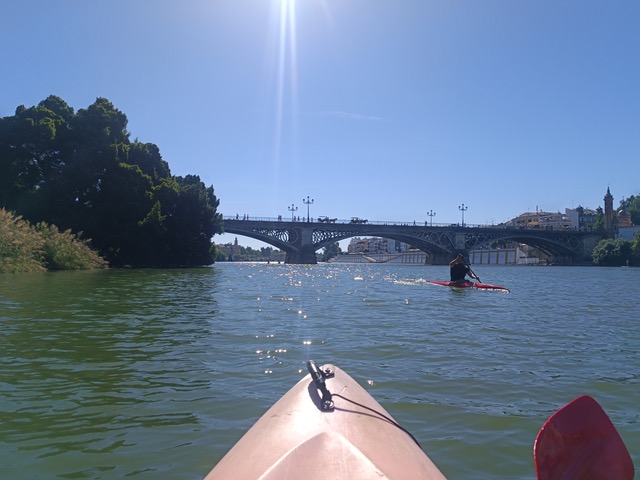
View towards the Paris-inspired Triana bridge from 1852. Photo © Karethe Linaae
Most people who visit Seville admire the cathedral and the Giralda tower, stroll around the narrow alleys of La Judería, and perhaps peek into the Alcázar fort. The rest of the time is usually reserved for tapas and shopping. There are many lovely ways to experience the Andalusian capital but the most unforgettable is perhaps the least common. Only very few visitors will see the city from within the Guadalquivir River- the city’s essential artery and the reason that Seville was established on this flat and rather barren land in the first place. So why not combine sightseeing with a bit of exercise and rent a kayak to explore the historic city?
Kayak rental by the riverbank
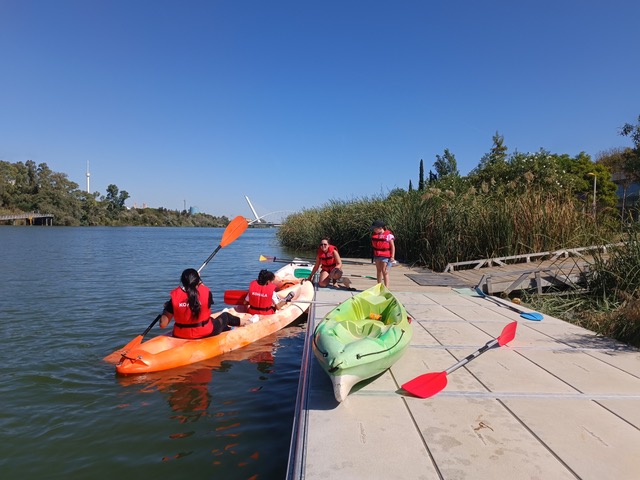
Starting by the floating dock. Photo © Karethe Linaae
Ever since I read about the Viking’s conquest of the city (that time called Išbīliya) in the year 844, I have always wanted to see Seville from the river. Preferably with a Viking ship, but let’s be realistic here… That particularly bloody story will have to wait until I can arrange a meeting with the town archaeologist and dig a bit more. In the meantime, let us rent a kayak for a 2.5-hour guided tour of Guadalquivir, straight through Seville’s city centre.
Several companies offer kayak rentals along the river, and we went with Naturanda, a company that arranges guided kayak trips all around the country. I cannot guarantee they are the best alternative. Still, their kayaks are conveniently located at Seville’s rowing club in the town centre with several parking lots only a few minutes’ walk away. The club also has showers and lockers (remember to bring a lock), and a small café selling water bottles.
We arrive early (the Scandinavian curse …) and find neither our guide nor a representative from the company. But a couple of minutes past the starting time, our friendly local guide saunters in. Alejandro is a fourth-year medical student and a native sevillano who is very proud of his city. We speak Spanish together, though he also speaks quite well English and French. While waiting for the last four paddlers to join us, we do some stretching, put on life jackets (compulsory) and bring the kayaks down to the floating dock where we will soon set off. We decided on a double kayak so that I would have a chance to take photos. The hull is of the heavy plastic type that one sits right on top of, without a keel or spray skirt. They are nothing like the fast, responsive river or sea kayaks, but on the other hand, they are almost impossible to flip (handy for the photographer). Therefore, it is considered a perfectly safe and fun family activity.
Since the rest of the group hasn’t shown up yet, we paddle around on our own, checking out life along the riverbank, which includes beautiful flowering bushes, pampas grass, dragonflies and many species of birds. There are also people fishing by the river, although the water pollution has been proven to pose a risk to the local flora and fauna.
While we are waiting anyhow, why don’t we take a trip back in history to learn a bit more about the river?
Looking back
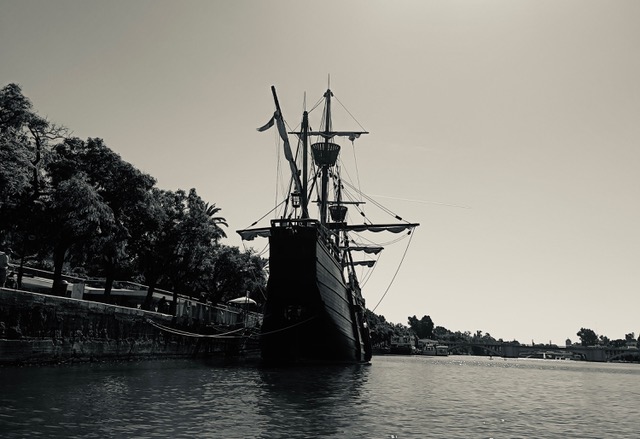
Perhaps it looked like this in the 17th Century? Photo © Karethe Linaae
The name Guadalquivir comes from the Arabic al-wādī l-kabīr meaning Mighty River. And it is rather mighty with its 657 kilometres from its source in Sierra de Cazorla in Jaén, through the provinces of Córdoba and Seville, until it flows into the Atlantic Ocean by Sanlúcar de Barrameda in the Bay of Cádiz. Today it is Spain’s only navigable river that still brings large ships to Sevilla, though in Roman times, one could sail even further - as far as Córdoba.
Guadalquivir played an important role in Seville’s history. The city fought sieges and conquering armies that came up the river through the millennia. First, the Phoenicians, then the Carthaginians. Later, from 205 B.C., the Romans exported minerals, salt and fish from Seville (Hispalis) to Rome. Under the Arab rule (712 to 1248) the Moors built a large anchorage and watchtowers to strengthen the city’s defence. This was also one of the places where they had enormous chains submerged under the water, which they could tighten to destroy enemy ships. So, this is one of the ways they stopped the Vikings’ other attempts at reconquering the city.
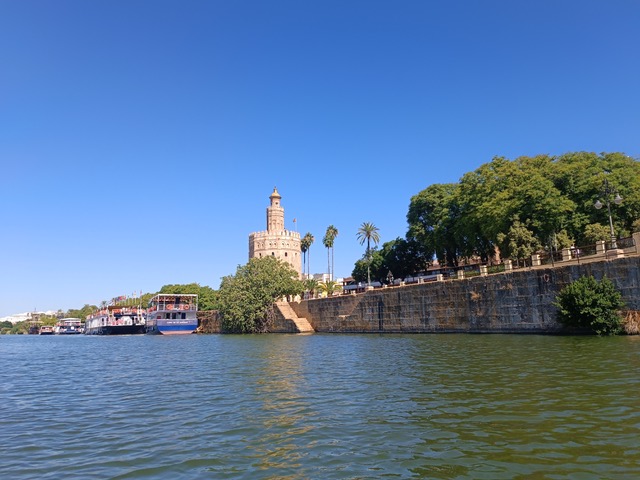
Torre de Oro with riverboats in the background. Photo © Karethe Linaae
In the 15th Century, the city’s shipyard was expanded with the exports of grains, oil, wine, leather, cheese, fish, metal as well as silk to the rest of Europe. With the discovery of the Americas, Seville became Spain’s economic trading centre, a trade monopoly they later lost to Cádiz. Yet today, almost 3000 years after the first exports started from this port, cargo ships and smaller cruise ships can still sail 90 kilometres into the mainland to reach Seville.
Life on the water
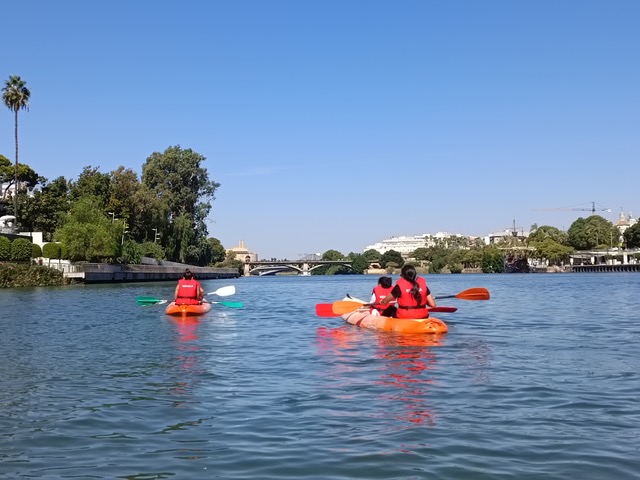
River paddling with the entire family. Photo © Karethe Linaae
The others in our group are two mothers from Paris with their young daughters. The children are ever so keen and have no problem following us, even if we are not the only ones on the river today. In addition to a couple of smaller river cruises that take passengers around, we encounter rowers in single scullers to eight-man boats as well as other kayakers and paddleboarders with and without instructors.
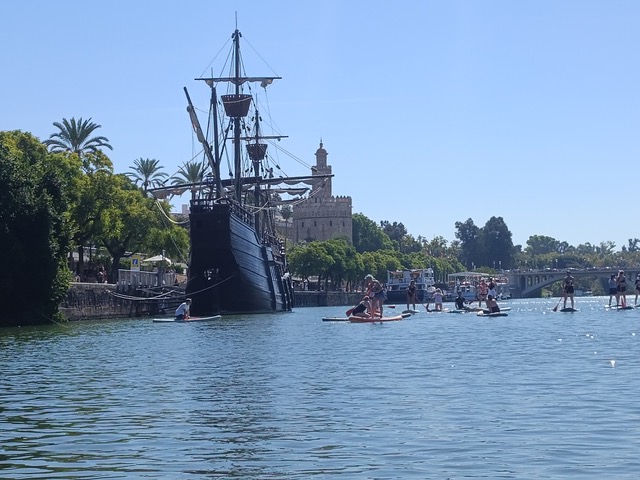
Lots of activities on the river. Photo © Karethe Linaae
Since the river barely has a current in this section (which is an artificial branch) and largely due to the hot climate, Seville has become a training ground for national and international paddling and rowing teams, especially in the winter months. The river also has a two-kilometre-long international regatta course. But for us who are a little less proficient, this river section is like a calm waveless lagoon.
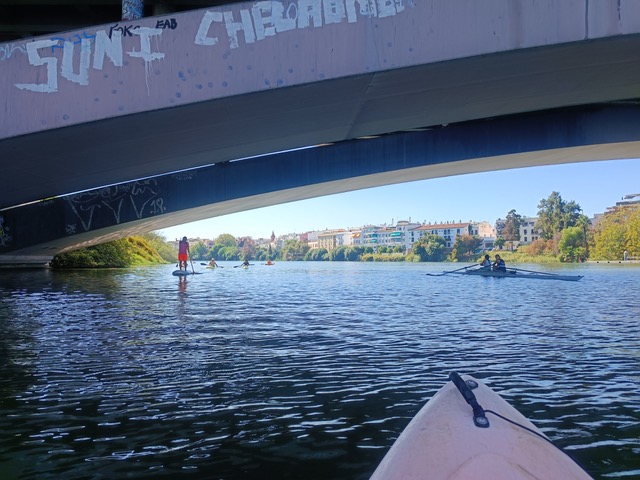
Going under the Cachorro bridge. Photo © Karethe Linaae
Our group of seven follows the left bank, keeping a distance from the rowers who speed by. First, we pass the Cartuja pedestrian bridge and the Cachorro bride which is covered in graffiti, before arriving at the oldest bridge - Puente de Triana from 1852.
The interesting thing about these bridges is that although Córdoba had a bridge already in Roman times, Seville didn’t have a proper bridge crossing the Guadalquivir until the 1800s. Apparently, for several centuries the town was only connected with so-called ‘boat bridges’, consisting of a dozen boats chained together and covered with planks that led pedestrians, animals and horse carriages across the river. This is one of those times when I wish I could time-travel!
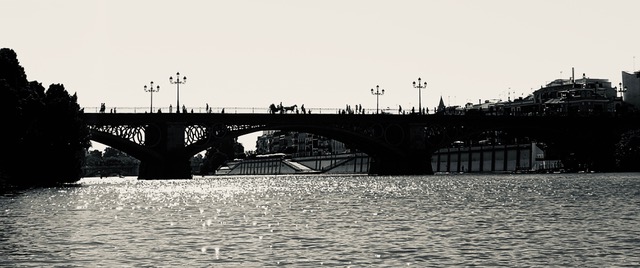
The Triana bridge as I imagine it looked like in the 1800s. Photo © Karethe Linaae
The bridge that leads to the charming Triana neighbourhood, was designed by two French engineers and inspired by the original Pont du Carrousel in Paris. From here, we can see a copy of one of the ships that Columbus sailed to the Americas. Behind is the ‘gold’ watchtower Torre de Oro whose construction began in 1220. The name does not refer to the presence of real gold in the tower, but rather the tower’s golden reflections in the river explains Alejandro. We pass under the San Telmo bridge with a nearby palace of the same name and continue to Puente de los Remedios, from where we can admire the magnificent María Luisa Park and even a regatta in the distance.
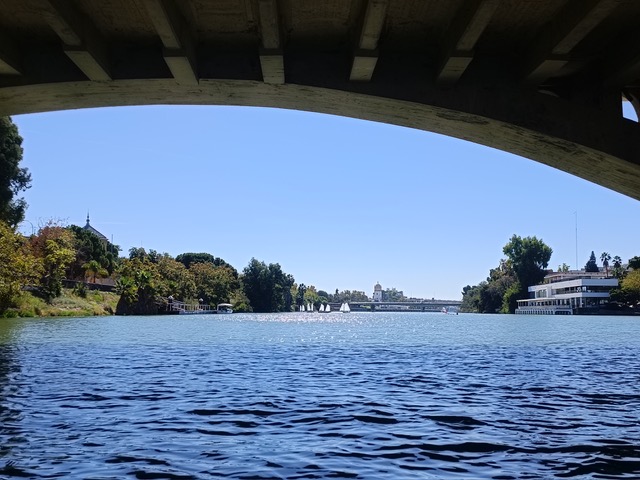
Regatta ion the river. Photo © Karethe Linaae
This is our turning point, and we return by paddling along the other riverbank. Alejandro informs us that what we see on our left is Seville’s most exclusive residential street, Calle Betis. The street doesn’t have the city’s largest nor the most luxurious homes, but the view of the river makes it unique, and thus the most desirable and expensive. Everybody in the group pick our favourite house with a roof terrace overlooking the river.
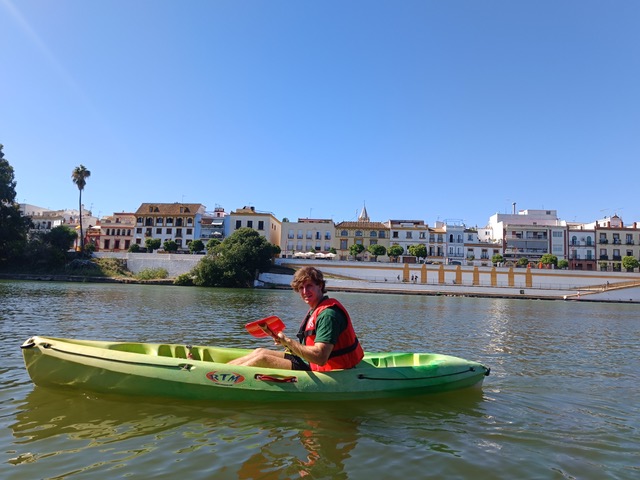
Alejandro with Calle Betis. Photo © Karethe Linaae
Paddling along the Triana neighbourhood once again, Alejandro points to a church. This is where his brotherhood departs from every Semana Santa with several hundred nazarenos to carry the religious statues across the bridge. Next, we pass the site for the 1992 World’s Fair, which has been abandoned ever since. Clearly this isn’t the Costa del Sol. Otherwise, property investors would have taken it over ages ago!
Safely back at the rowing club, both young and old agree that we have had a couple of fascinating hours. Kayaking the Guadalquivir is a safe, fun and unique way to experience Sevilla from a new vantage point. And, speaking for myself, it is almost as if I feel a bit more local after learning some of the city’s many secrets – by water.
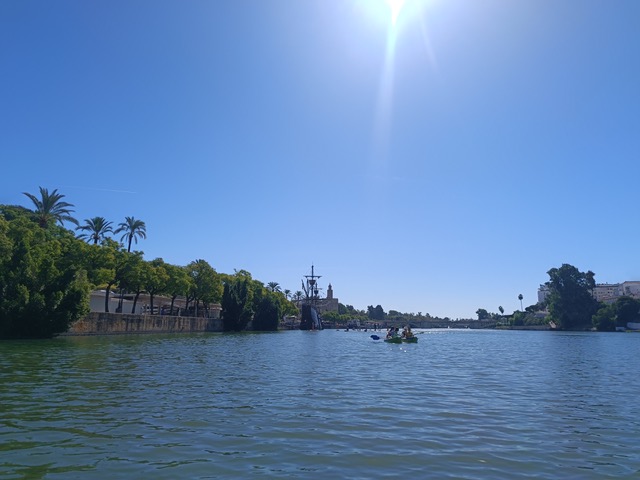
Guadalquivir in all its glory. Photo © Karethe Linaae